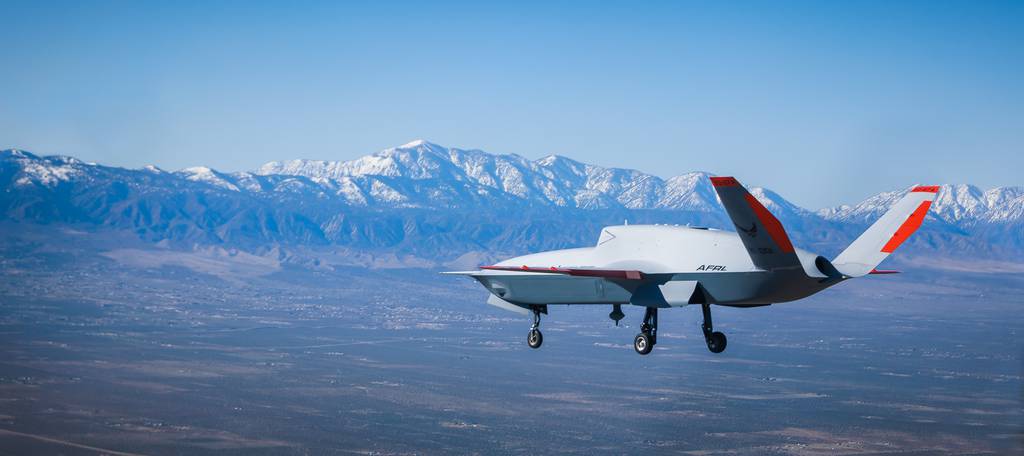
The Air Force Research Laboratory hopes a common car manufacturing technique might unlock the solution for building affordable autonomous drones that can be fielded in large numbers.
The Aerospace Systems Directorate of AFRL, the service’s research and development arm, on Feb. 28 flew a General Atomics-made XQ-67A drone for the first time.
But what makes this aircraft different, said Doug Meador, the head of autonomous collaborative platform capabilities at AFRL’s Aerospace Systems Directorate, is that it was built on a chassis that could serve as the foundation for a variety of other drones.
This concept, which the automobile industry calls “platform sharing,” has been a standard practice there for decades, with carmakers mass-producing common underlying frames on which they build multiple vehicle models. Auto manufacturers say doing so saves time and money, improves a car’s reliability, and makes it simpler to keep a supply chain of parts flowing since models have fewer variances.
AFRL hopes the same approach will lead to a revolution in drone construction, allowing easier and greater mass production and driving down costs — potentially making it easier to create fleets of drone wingmen flying alongside crewed fighters.
“What if we built airplanes the same way the automotive industry built cars?” Meador said in a Tuesday interview. “What if we came up with a common chassis, or a framework around which you can put disparate performing types of aircraft, and what would that do [for] both being able to build the aircraft quickly and build them cheaper?”
The Air Force is focused on fielding a series of drones called Collaborative Combat Aircraft that could operate autonomously, in some cases serving as “wingmen” for fighters such as the F-35 and the in-the-works Next Generation Air Dominance platform. The Air Force wants these CCAs to carry out multiple missions, including strike, reconnaissance, and electronic warfare.
But if the CCA plan is to work, the Air Force will have to be able to field large numbers of them relatively inexpensively — a concept officials refer to as “affordable mass.” Meador hopes this common platform structure strategy could help the Air Force save on drone construction and achieve the kind of mass that is key to the CCA concept.
And the successful first flight of the XQ-67A, Meador said, showed this concept could work, even if the XQ-67 itself never transitions to a program of record. Only one XQ-67 has been built so far, but he declined to say if more are on the way.
“It’s an alternative [development option] that, to date, we have not had,” Meador said. “We’ve essentially validated it by flying the XQ-67.”
The XQ-67A is designed to carry sensors and have the potential to fly autonomously — though it now can only be flown remotely — alongside a crewed fighter to provide intelligence, surveillance and reconnaissance.
Its first flight occurred at General Atomics’ Gray Butte Flight Operations Facility near Palmdale California, and was a relatively short, easygoing test, Meador said. More ambitious flight tests are planned in the near future, he said, to fully understand whether the XQ-67 can do what it was designed for.
“We still need to characterize some of the flying qualities and things like that [of the XQ-67] so we can turn it from a flight test program to a possible experimentation asset,” Meador said.
Other drones that could be built on the same underlying chassis in the future could carry out other missions such as conducting strikes on enemy targets, or electronic warfare, Meador said — but they would be an entirely different aircraft than an XQ-67.
“If we were to decide to go and build an off-board weapons station next, all the work that went into [building the XQ-67 sensor station] is already sunk, and we’ve already paid for it,” Meador said.
The XQ-67A grew out of a 2014 AFRL initiative called Low-Cost Attritable Aircraft Technologies. Those ideas helped shape the Air Force’s CCA concept, and also led AFRL to explore the potential for its own platform sharing strategy.
AFRL worked with multiple vendors on the LCAAT initiative to figure out how to make a low-cost drone that could perform various missions, which evolved into a demonstration program that led Kratos Defense and Security Solutions to build the XQ-58A Valkyrie, he said.
Valkyrie experiments
The Valkyrie experiments showed it was possible to build a drone that can fly for long ranges, at high sub-sonic speeds, and with sufficient payloads for just a few million dollars, Meador said. So then, he said, AFRL set a more ambitious goal of building a drone that could share an underlying platform with other drones carrying out different missions.
This Low-Cost Attritable Aircraft Platform Sharing program worked through a lot of questions along the way, such as figuring out what the common chassis should look like, how big it could be, and how many similar structures it could share to accommodate a variety of drones. AFRL chose General Atomics to build the XQ-67 in late 2022.
It’s now hard to say how much the XQ-67 might cost, Meador said, because only one has so far been built and prices on aircraft typically don’t stabilize until multiple units have been built.
But he hopes the cost-per-pound of the XQ-67′s air vehicle, without sensors or other additional capabilities, will be roughly in line with the smaller XQ-58 Valkyrie. The XQ-67 is about 50% heavier than the Valkyrie.
Having a common underlying structure could also make it easier and cheaper to develop subsequent generations of drones, Meador said. If the platform within a sensing drone is still up to date, for example, and only the sensors need to be modernized, Meador said that would simplify the new drone’s development.
“It’ll keep the cost down because we’re not going back and, from the ground up, redesigning everything from scratch,” Meador said.
Author: Stephen Losey
Source: DefenseNews



